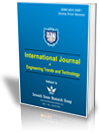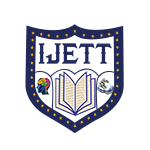Grid Interconnection of Renewable Sources with Three-phase Transformer-Less Boost Multilevel Inverter Topology with Reduced Harmonics
Grid Interconnection of Renewable Sources with Three-phase Transformer-Less Boost Multilevel Inverter Topology with Reduced Harmonics |
||
 |
 |
|
| © 2025 by IJETT Journal | ||
| Volume-73 Issue-3 |
||
| Year of Publication : 2025 | ||
| Author : Gaddam Bhagyalaxmi, Balasubbareddy Mallala, P. Satish Kumar |
||
| DOI : 10.14445/22315381/IJETT-V73I3P141 | ||
How to Cite?
Gaddam Bhagyalaxmi, Balasubbareddy Mallala, P. Satish Kumar, "Grid Interconnection of Renewable Sources with Three-phase Transformer-Less Boost Multilevel Inverter Topology with Reduced Harmonics," International Journal of Engineering Trends and Technology, vol. 73, no. 3, pp. 581-589, 2025. Crossref, https://doi.org/10.14445/22315381/IJETT-V73I3P141
Abstract
Connecting renewable sources in parallel to the grid with conventional sources is a challenging task. As the output of renewable sources is unstable, it needs to be stabilized using several passive and active elements to share power with the grid. The circuit system needs to be more efficient and stable with reduced ripple and harmonic content. In this paper, a three-phase transformer-less boost MLI topology is introduced with a PV array and PMSG wind farm renewable sources connected to the input. The MLI is connected to the grid through an LC passive filter to mitigate harmonic content. The proposed MLI has voltage-dividing capacitors to create voltage levels. The inverter comprises two stages, which include a voltage-level generator circuit and an inverting circuit. The voltage level generator circuit creates multilevel voltages only in a positive direction. The multilevel DC voltage is converted to AC by the inverting circuit, sharing power with the grid. The reference signal to the multilevel inverter pulse modulation technique controller is generated by modified fuzzy MPPT-based p-q control theory for efficient renewable power sharing to the grid. The boost converter at the input of the multilevel inverter ensures maximum power extraction controlled by the MPPT technique. The multilevel inverter ensures reduced harmonic AC voltage generation for sharing PV array power with low THD value to the grid.
Keywords
Multi-Level Inverter (MLI), Photo Voltaic (PV), Permanent Magnet Synchronous Generator (PMSG), L-C-L (Inductor-Capacitor-Inductor), Active and reactive power (p-q), Maximum Power Point Tracking (MPPT), Total Harmonic Distortion (THD).
References
[1] Mikalai Filonchyk et al., “Greenhouse Gases Emissions and Global Climate Change: Examining the Influence of CO2, CH4, and N2O,” Science of The Total Environment, vol. 935, 2024.
[CrossRef] [Google Scholar] [Publisher Link]
[2] Kashif Abbass et al., “A Review of The Global Climate Change Impacts, Adaptation, and Sustainable Mitigation Measures,” Environmental Science and Pollution Research, vol. 29, pp. 42539-42559, 2022.
[CrossRef] [Google Scholar] [Publisher Link]
[3] Muhammad Kabir et al., “Climate Change Due to Increasing Concentration of Carbon Dioxide and Its Impacts on Environment in 21st Century; A Mini Review,” Journal of King Saud University-Science, vol. 35, no. 5, pp. 1-7, 2023.
[CrossRef] [Google Scholar] [Publisher Link]
[4] Abidur Rahman, Omar Farrok, and Md. Mejbaul Haque, “Environmental Impact of Renewable Energy Source Based Electrical Power Plants: Solar, Wind, Hydroelectric, Biomass, Geothermal, Tidal, Ocean, And Osmotic,” Renewable and Sustainable Energy Reviews, vol. 161, 2022.
[CrossRef] [Google Scholar] [Publisher Link]
[5] Abdalla Y. Mohammed, Farog I. Mohammed, and Mamoun Y. Ibrahim, “Grid-Connected Photovoltaic System,” 2017 International Conference on Communication, Control, Computing and Electronics Engineering, Khartoum, Sudan, pp. 1-5, 2027.
[CrossRef] [Google Scholar] [Publisher Link]
[6] Marcolino Humberto Díaz-Araujo et al., “Analysis of Grid-Connected Photovoltaic Generation Systems in the Harmonic Domain,” Energies, vol. 12, no. 24, pp. 1-14, 2019.
[CrossRef] [Google Scholar] [Publisher Link]
[7] Sachin Jain, and Vivek Agarwal, “A Single-Stage Grid Connected Inverter Topology for Solar PV Systems with Maximum Power Point Tracking,” IEEE Transactions on Power Electronics, vol. 22, no. 5, pp. 1928-1940, 2007.
[CrossRef] [Google Scholar] [Publisher Link]
[8] Samuel Vasconcelos Araujo, Peter Zacharias, and Regine Mallwitz, “Highly Efficient Single-Phase Transformer-Less Inverters for Grid-Connected Photovoltaic Systems,” IEEE Transactions on Industrial Electronics, vol. 57, no. 9, pp. 3118-3128, 2021.
[CrossRef] [Google Scholar] [Publisher Link]
[9] Anurag Priyadarshi, Pratik Kumar Kar, and Srinivas Bhaskar Karanki, “A Single Source Transformer-Less Boost Multilevel Inverter Topology with Self-Voltage Balancing,” IEEE Transactions on Industry Applications, vol. 56, no. 4, pp. 3954-3965, 2020.
[CrossRef] [Google Scholar] [Publisher Link]
[10] Kasinath Jena et al., “Transformer-Less Multilevel Inverter (TMLI) with Reduced Device Count and Voltage Stress,” e-Prime-Advances in Electrical Engineering, Electronics and Energy, vol. 7, pp. 1-11, 2024.
[CrossRef] [Google Scholar] [Publisher Link]
[11] Mohamed Trabelsi, Hani Vahedi, and Haitham Abu-Rub, “Review on Single-DC-Source Multilevel Inverters: Topologies, Challenges, Industrial Applications, and Recommendations,” IEEE Open Journal of the Industrial Electronics Society, vol. 2, pp. 112-127, 2021.
[CrossRef] [Google Scholar] [Publisher Link]
[12] Mohammad Amani, Milad Niaz Azari, and Mohammad Rezanejad, “Single Source Self‐Balanced Switched‐Capacitor Multilevel Inverter with Reduced Number of Semiconductors,” IET Power Electronics, vol. 16, no. 4, pp. 575-583, 2022.
[CrossRef] [Google Scholar] [Publisher Link]
[13] Emad Samadaei et al., “Single DC Source Multilevel Inverter with Changeable Gains and Levels for Low-Power Loads,” Electronics, vol. 9, no. 6, pp. 1-15, 2020.
[CrossRef] [Google Scholar] [Publisher Link]
[14] Jiahui Jiang, Zhihao Liang, and Huicui Wang, “A Comprehensive Review on Single DC Source Multilevel Inverters for Renewable Energy Applications,” Electrical Engineering, vol. 105, no. 6, pp. 3895-3917, 2023.
[CrossRef] [Google Scholar] [Publisher Link]
[15] Akanksha Kumari et al., “A Single Source Five-Level Switched-Capacitor Based Multilevel Inverter with Reduced Device Count,” e-Prime-Advances in Electrical Engineering, Electronics and Energy, vol. 5, pp. 1-14, 2023.
[CrossRef] [Google Scholar] [Publisher Link]
[16] Mohamed Trabelsi, Hani Vahedi, and Haitham Abu-Rub, “Review on Single-Dc-Source Multilevel Inverters: Topologies, Challenges, Industrial Applications, and Recommendations,” IEEE Open Journal of the Industrial Electronics Society, vol. 2, pp. 112-127, 2021.
[CrossRef] [Google Scholar] [Publisher Link]
[17] Asim Datta, Rishiraj Sarker, and Imraj Hazarika, “An Efficient Technique Using Modified p-q Theory for Controlling Power Flow in a Single-Stage Single-Phase Grid-Connected PV System,” IEEE Transactions on Industrial Informatics, vol. 15, no. 8, pp. 4635-4645, 2019.
[CrossRef] [Google Scholar] [Publisher Link]
[18] Haoyan Liu, Yuzhi Zhang, and H. Alan Mantooth, “Residential Renewable Energy Distribution System with PQ Control,” 2015 IEEE International Conference on Building Efficiency and Sustainable Technologies, Singapore, pp. 33-38, 2015.
[CrossRef] [Google Scholar] [Publisher Link]
[19] Min-Rong Chen et al., “Optimal P-Q Control of Grid-Connected Inverters in a Microgrid Based on Adaptive Population Extremal Optimization,” Energies, vol. 11, no. 8, pp. 1-19, 2018.
[CrossRef] [Google Scholar] [Publisher Link]
[20] Saban Ozdemir, Necmi Altin, and Ibrahim Sefa, “Fuzzy Logic Based MPPT Controller for High Conversion Ratio Quadratic Boost Converter,” International Journal of Hydrogen Energy, vol. 42, no. 28, pp. 17748-17759, 2017.
[CrossRef] [Google Scholar] [Publisher Link]
[21] B.G. Sujatha, and G.S. Anitha, “Enhancement of PQ in Grid Connected PV System Using Hybrid Technique,” Ain Shams Engineering Journal, vol. 9, no. 4, pp. 869-881, 2018.
[CrossRef] [Google Scholar] [Publisher Link]

